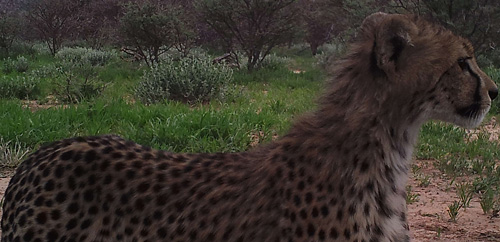
Go Green fund instrumental in Cheetah conservation

The Cheetah Conservation Fund (CCF) received N$147,055 from the Go Green Fund for their three year programme to determine the distribution, density and human-carnivore conflict areas for cheetah, African wild dogs and other key large carnivores across the Greater Waterberg Landscape.
The Programme which is in its last year has made significant progress all thanks to local bank Nedbank, which has shown its commitment towards conservation and sustainable development by securing the funds for the Go Green Fund by teaming up with the Namibia Nature Foundation (NNF) and creating a real partnership that deliver.
According to Stéphanie Periquet, Cheetah Conservation: Wildlife Ecology Research Manager, “The current distribution and densities of key carnivore species including the African wild dog and cheetah across the Waterberg is unknown. However, previous studies have shown that there is a high level of retaliation killing of carnivores due to livestock loss across the Waterberg. This project aims to determine the density of key large carnivores in the GWL and characterise human-carnivore conflict areas.”
The Go Green Fund has been instrumental in helping CCF reach these goals by providing funding for the purchase of 40 camera traps and fuel for their field vehicles. The cameras have been deployed over the past 2 years around in Waterberg Plateau National Park, on freehold farms and over 1 300 000 pictures have been documented. The cameras will now be moved to sample the communal areas of the GWL. In addition, CCF has conducted workshops and questionnaire surveys across the GWL to assess husbandry practices and the level of livestock losses as well as human-wildlife conflicts.
Gabriela Fleury, Human Dimensions Research Manager at CCF said that, the next stage of the Go Green project will commence on communal farmlands in the eastern communal conservancies of Namibia (Okamatapati, African Wild Dog and Otjituuo).
“We have created a pre-defined 4 by 4 km grid for the survey areas where we’ll place and monitor 40 remote camera traps across these conservancies. Placement of camera traps will be positioned during February 2018, at random locations along with collaborative permission from communal farmers to capture the wet season. The camera traps will remain in position for a period of 30 days, after which photographs will be analysed. Similar to the study in the Greater Waterberg Conservancy, two surveys will be conducted, one in the wet and one in the dry season respectively. Our research team will also conduct interviews with communal farmers concerning human-wildlife conflict,” she added.
Meanwhile, Nedbank Namibia said funding from the private sector is therefore an absolute imperative to sustain the commitments made towards Namibia’s environmental conservation and protection.












































